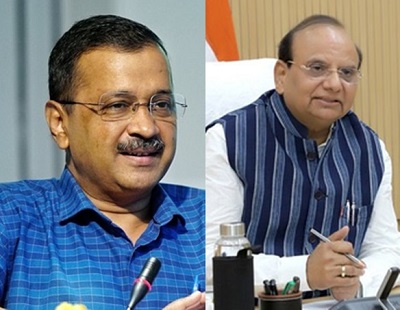New Delhi, (Samajweekly) Delhi Lieutenant Governor (L-G) V.K. Saxena on Tuesday wrote to incarcerated Chief Minister Arvid Kejriwal, saying that due to the wrong policies of the Delhi government, over two crore people are deprived of drinking water in the national capital.
“Of about 2.5 crore people in the city, more than 2 crore (over 80 per cent) people are deprived of drinking water supply in varying degrees, especially in unauthorised colonies, slum clusters and to a lesser extent, even in organised developed colonies,” the L-G wrote.
The L-G said that the Economic Survey 2023-24, tabled by Delhi Finance Minister Atishi in the recent Budget Session brings out some startling facts.
“Over last decade, water treatment capacity grew marginally from 906 MGD to 946 MGD, barely 4.4 per cent increase. During the same period, the population of the city has grown significantly by 15 per cent. The overall shortfall in water supply amounts to about 290 MGD. Of the total water being supplied, 120 MGD comes from ground water extraction, which is also a gross exaggeration. I am sure that you are aware that of the sixteen Ranney wells, five are non-functional. Similarly a large number of tubewells are also dysfunctional,” the L-G said.
He said that in Delhi, 7 per cent of households – an average of 20 lakh people – still do not receive piped water supply. The accumulated loan and interest liability of DJB stands at a staggering Rs 73,000 crores.
“I am constrained to write this open letter to you, knowing that a direct communication with you in your present circumstances is not possible. However, I am sure that you would be able to access news and library facilities to read these words of anguish,” the L-G said.
“Your Minister’s hasty missive to me is an admission of these failures and defaults of performance of your government and amount to facile attempts at shrugging responsibility off, a complex problem.”
He said that the minister has yet again targeted the Chief Secretary, Chief Executive Officer of DJB, officers of Finance and Urban Development Department.
“It has almost now become habitual on part of your ministers to blame officers for their own failures, be it in the field of health, hospitals, sanitation, education or water supply,” the L-G said.
The L-G said that having underlined the inadequate supply of water as the cause behind the incident, Finance Minister Atishi has ironically indicted her own government of more than 9 years.
“Her note indeed is a prima facie admission of guilt, inaction and inefficiency over the past almost 10 years,” the L-G said.
He said that the percentage of “unaccounted for water” that is a sum of water leakages by way of transmission and distribution losses, water theft and non-payment of dues, saw a sharp increase from 45 per cent in 2015 to 58 per cent in 2022-2023.
“In 2015, of the 906 MGD of water treated, only 498 MGD was accounted for. In 2022-23, of the 946 MGD treated, barely 397 MGD are accounted for. Over the last decade, net water availability has decreased by more than 100 MGD due to the criminal neglect by your Government,” the L-G mentioned.
He said that in the last 9 years that is since 2015, Rs 28,400 crore has been spent as Capital Expenditure by DJB. However, according to the Economic Survey 2023-24, over the last decade, water treatment capacity has grown marginally from 906 MGD to 946 MGD, barely 4.4 per cent increase.
“During the same period, the population of the city has grown significantly by 15 per cent. The overall shortfall in water supply amounts to about 290 MGD,” the L-G said.
He said that the percentage of “unaccounted for water” that is a sum of water leakages by way of transmission and distribution losses, water theft and non-payment of dues, saw a sharp increase from 45 per cent in 2015 to 58 per cent in 2022-2023.
“In Singapore, “unaccounted for water” is just 5 per cent, compared to Delhi’s 58 per cent. Even other Indian cities fare much better than Delhi – Chennai (35 percent), Mumbai (27 per cent), Pune (35 per cent),” the L-G wrote.
He wrote that in 2015, of the 906 MGD of water treated, only 498 MGD was accounted for.
“In 2022-23, of the 946 MGD treated, barely 397 MGD are accounted for,” the L-G letter concluded.









